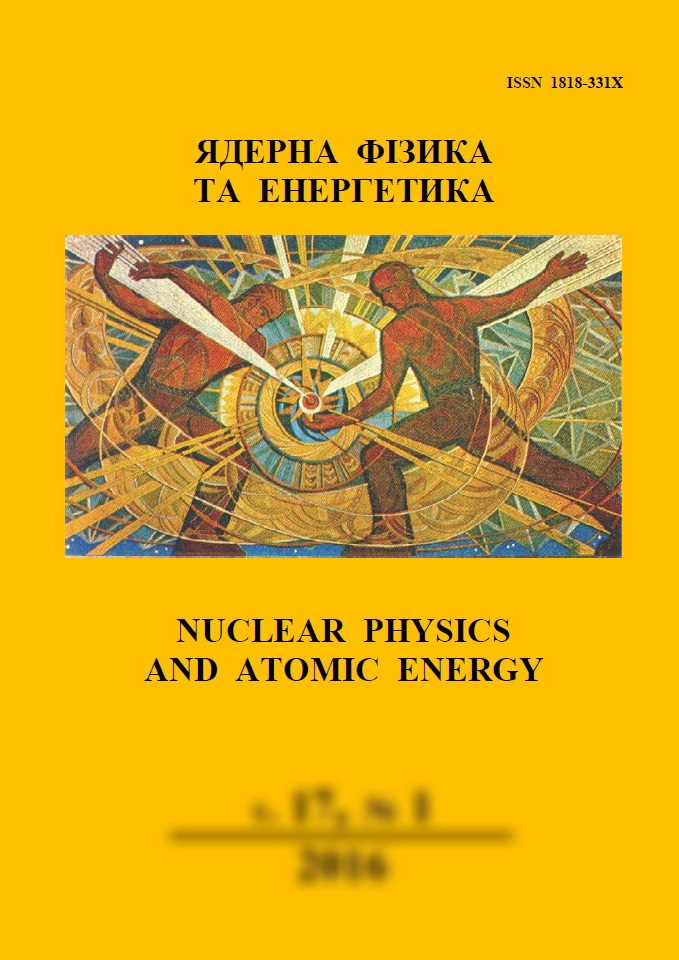 |
Ядерна фізика та енергетика
Nuclear Physics and Atomic Energy
ISSN:
1818-331X (Print), 2074-0565 (Online)
Publisher:
Institute for Nuclear Research of the National Academy of Sciences of Ukraine
Languages:
Ukrainian, English
Periodicity:
4 times per year
Open access peer reviewed journal
|
Nucl. Phys. At. Energy 2003, volume 4, issue 1, pages 63-68.
Section: Radiation Physics.
Received: 10.12.2002; Published online: 30.03.2003.
 Full text (ru)
Full text (ru)
https://doi.org/10.15407/jnpae2003.01.063
Energy position of bistable defect (CiCs)0 in "В" configuration in a forbidden zone of n-Si
A. P. Dolgolenko, P. G. Litovchenko, M. D. Varentsov, G. P. Gaidar
Institute for Nuclear Research, National Academy of Sciences of Ukraine, Kyiv, Ukraine
Abstract:
Float-zone and phosphorus-doped n-Si samples after irradiation by fast-pile neutrons and subsequent
annealing at room temperature were investigated. The calculation of effective concentration of carriers after
irradiation was carried out in the framework of Gossick's model taking into account the recharges of defects
both in conducting matrix of n-Si and in the space-charge region of defect clusters. The distribution function
of electrons on the acceptor level of bistable defect (CiCs)0
when the concentration of this defect is the
function of the Fermi level in conducting matrix of n-Si is determined. The concentration of bistable
interstitial-carbon-substitutional-carbon pair and its energy level at (Ес - 0.123 eV) in forbidden band of
silicon were calculated. On the observable level of stable configuration CiCs (A-)-defects at (Ес
- 0.147 eV)
the theoretical change of carriers concentration in the conduction band simulated by the recharges (CiCs)0
was imposed. The concentration of these (CiCs)0
-defects has been changed in the process of their recharges.
It is shown that in n-Si with high carbon and oxygen concentration after affiliating of oxygen atoms to
bistable defect (CiCs)0
in a forbidden band of n-Si the stable defects not only in "А" but also in "В"
configurations are formed with energy levels at (Ес
- 0.13 eV) and (Ес
- 0.09 eV).
References:
1. Jellison G. E., Jr. Transient capacitance studies of an electron trap at Ec - ET = 0.105 eV in phosphorusdoped silicon. J. Appl. Phys. 53 (1982) 5715.
https://doi.org/10.1063/1.331459
2. Song L. W., Zhan X. D., Benson B. W., Watkins G. D. Bistable interstitial-carbon-substitutional-carbon pair in silicon. Phys. Rev. B 42 (1990) 5765.
https://doi.org/10.1103/PhysRevB.42.5765
3. Dolgolenko A. P. Variation of Carrier Removal Rate with Irradiation Dose in Fast-Pile Neutron Irradiated n-Si. phys. stat. sol. (a) 179 (2000) 179.
https://doi.org/10.1002/1521-396X(200005)179:1%3C179::AID-PSSA179%3E3.0.CO;2-3
4. Mac Evoy B. C., Watts S. J. Defect Engineering Radiation Tolerant Silicon Detectors. Gettering and Defect Engineering in Semiconductor Technology (GADEST' 97): Proc. of the 7th Inter. Autumn Meeting, Belgium, Spa, Oct. 5- 10, 1997 (Belgium, 1997) p. 221.
5. Gossick B. R. Disordered Regions in Semiconductors Bombarded by Fast Neutrons. J. Appl. Phys. 30 (1959) 1214.
https://doi.org/10.1063/1.1735295
6. Dolgolenko A. P., Fishchuk I. I. A-Centres Build-Up Kinetics in the Conductive Matrix of Pulled n-Type Silicon with Calculation of Their Recharges at Defect Clusters. phys. stat. sol. (a) 67 (1981) 407.
https://doi.org/10.1002/pssa.2210670207
